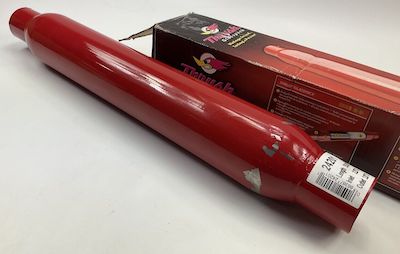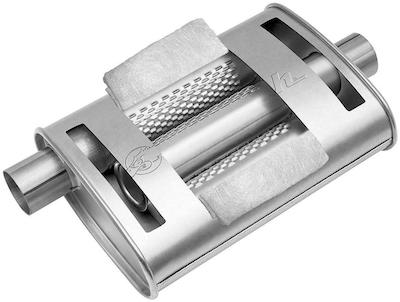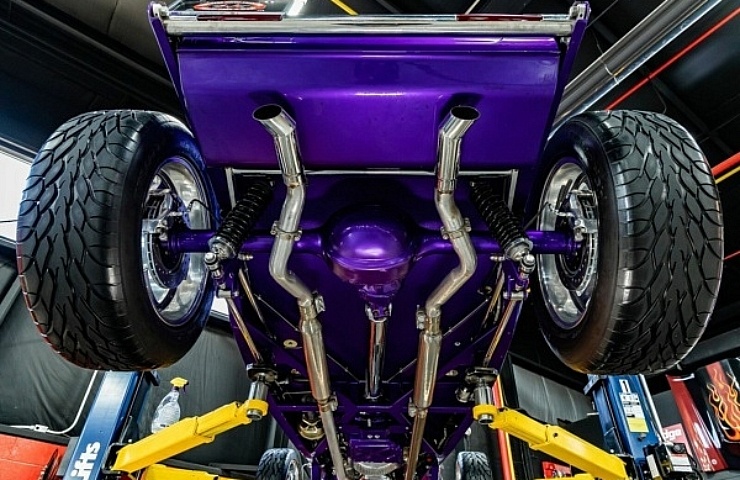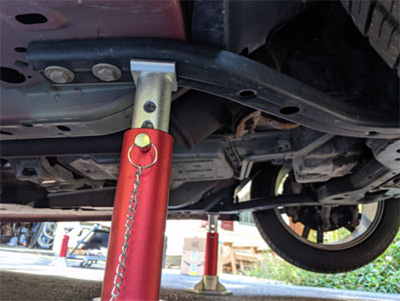Contents
What Is a Muffler?
The primary purpose of a muffler is to reduce the sounds coming from your vehicle’s engine. The muffler also directs toxic engine exhaust gasses from the vehicle’s cabin. It must align with state and federal regulations to minimize harmful tailpipe emissions.
The muffler consists of a series of tubes and internal chambers through which sound waves travel. Some mufflers also contain sound-absorbing materials, making the engine even quieter. When something goes wrong with the muffler—usually a crack or a hole that’s rusted through—you’ll immediately know by the increased volume of exhaust noise.
Muffler Types and the Sounds They Produce
When it comes to choosing which type of muffler you’ll need, the first task is to consult your vehicle’s owner’s manual, which should indicate what category of muffler is best for your vehicle.
There are three categories of mufflers to consider:
Chambered – Throaty Rumble

Flowmaster Super 44 Chambered Muffler
A chambered muffler is an excellent choice for street-legal performance vehicles like muscle cars, street machines, hot rods, and sporty coupes and sedans. They are designed to reduce noise while delivering a deep, throaty performance sound with rumbles and growls.
Straight Pipe or Glasspacks – Loud and Proud

Thrush Glasspack muffler
Designed for maximum exhaust flow and horsepower, these mufflers feature a straight, perforated pipe wrapped in sound-deadening material, such as fiberglass packing. These are preferred for racing vehicles, street hot rods, and custom car builders because the exhaust flows with minimal restriction and provides less sound reduction than chambered mufflers.
Turbo – Common Way to Reduce Noise

Thrush Hush Super Turbo Muffler
This is the most common type of muffler. It is designed to guide the exhaust gasses through S-shaped tubing for the best noise reduction. Some turbo styles incorporate additional tubing and sound-deadening material.
Read: How to Tune Your Exhaust Note
Is a Resonator the Same as a Muffler?
It’s common for people to think of a resonator and a muffler as the same thing. However, they are two different parts of the exhaust system. There’s a good chance your vehicle doesn’t have a resonator, which is only used to modify your vehicle’s sound.
Depending on the type of resonator you choose, it can cancel sounds you find annoying or amplify the exhaust sound. Enthusiasts with muscle or sports cars often prefer a louder, high-performance exhaust sound.
Shop now for mufflersTelltale Signs of a Bad Muffler
- Loud exhaust noise
- Engine rattling or misfiring
- Muffler dangling or scraping along the pavement
- Exhaust smell inside the cabin
- Condensation coming from the tailpipe
If you experience any of these conditions, inspect your muffler and exhaust system to determine if it needs repair or replacement.
DIY Muffler Replacement
The first step is to look in your vehicle owner’s manual to find the muffler style suggested by the manufacturer. If you cannot find a suggestion in the owner’s manual, you can call the dealership and ask a mechanic to help you make the right choice. Next, you’ll need to know if your vehicle has a single muffler or a dual exhaust system. If it’s dual exhaust, consider purchasing two mufflers.
Replacing a muffler is an attainable DIY project. Here is a step-by-step guide to accomplish the job in your garage.
- Put the vehicle in Park on level ground and set the emergency brake.
- Raise the vehicle with either a floor jack or lift ramps so you can access the underside and chock the wheels. Secure the vehicle using axle stands—raised to the desired height—and insert the locking pin. Slightly lower the vehicle to transfer the car’s weight to the stands.
- Remove the old muffler. If the muffler was welded to the tailpipe, use a Sawzall to cut the pipe. Some mufflers are clamped to the tailpipe, and you may need to use penetrating oil on the bolts if they are rusted.
- If the muffler is still not easy to remove, see if there is a muffler hanger on top of the muffler. Slide it off the hanger hook and remove the muffler.
- Hang the new muffler on the hanger hook and line the existing tailpipe with the new muffler. Be sure to mark the tailpipe with chalk or crayon where the muffler lines up to the tailpipe so you can cut the tailpipe to fit the muffler.
- Use a muffler clamp to secure the muffler to the tailpipe. Most tailpipes are 2 1/2 inches, but measure your tailpipe to be certain to get the correct size clamp.
That’s it—your new muffler is installed.
Shop now for mufflersMuffler Legal Requirements
If you’re driving a muscle car or street machine, you may have considered removing the muffler completely for a louder, more powerful, and meaner sound. But before you do, know that states and provinces have unique muffler laws. Regardless, every state requires motor vehicles to have a muffler. You could be pulled over and ticketed, especially if your vehicle’s exhaust system is too loud.
If you want to improve the sound of your performance vehicle without breaking the law, look into your state’s laws regarding permissible decibel standards and consider getting an aftermarket muffler specifically designed for performance.
Also, most states require some level of emissions testing to qualify your vehicle for license plate issuance and renewal, and a muffler does affect the amount of pollutants your car is putting into the air. So make sure you check the compatibility of your aftermarket muffler, or you might fail your next state inspection, requiring a costly exhaust/muffler repair or replacement. And yes, you could be ticketed if you ignore your state’s laws and move ahead with an illegal muffler that allows too much noise.






